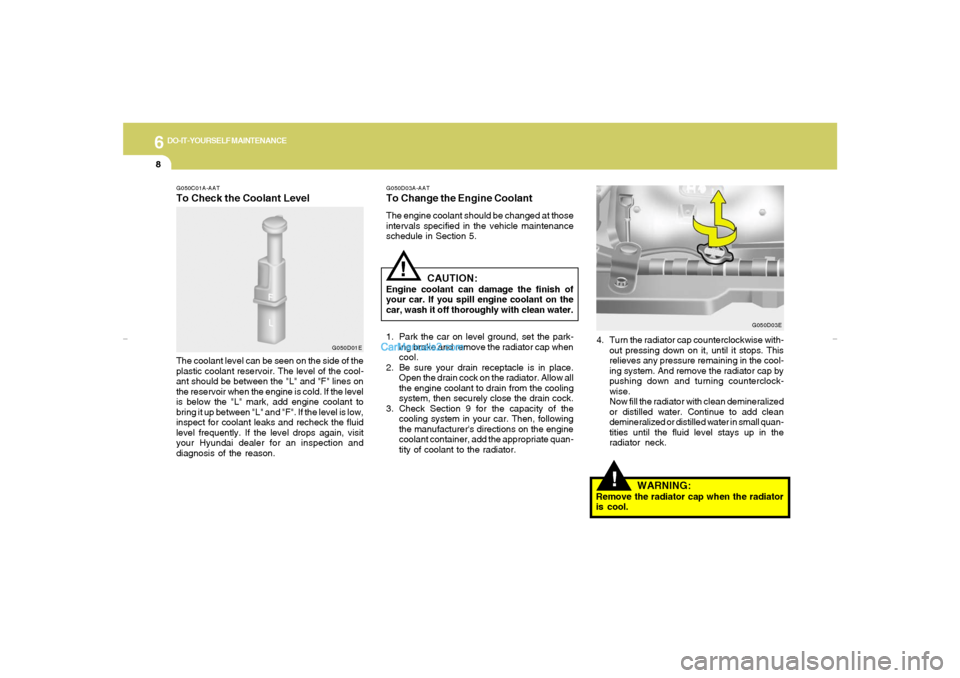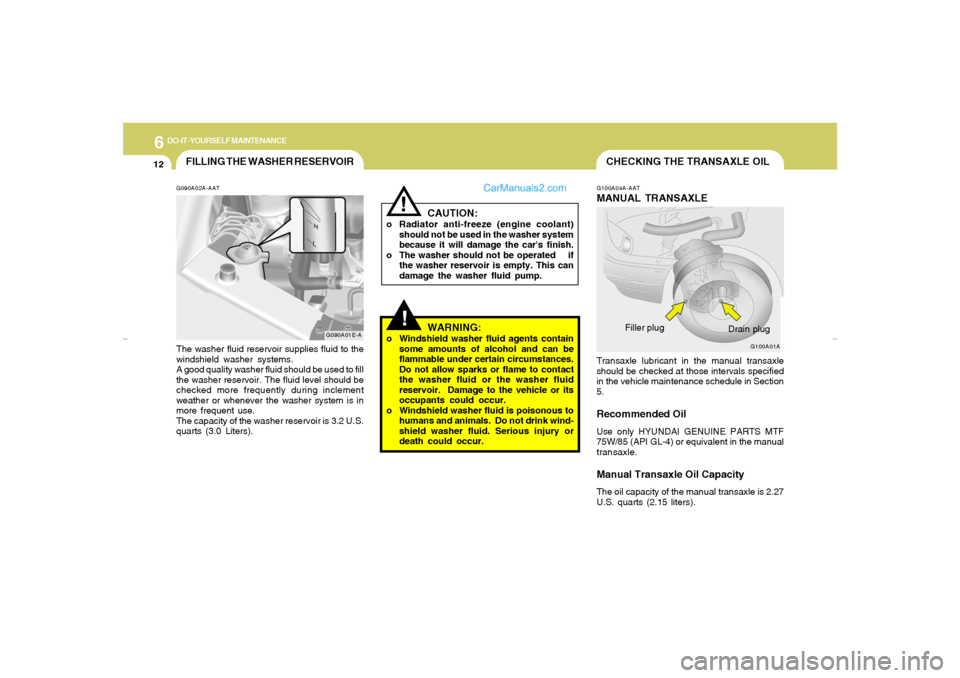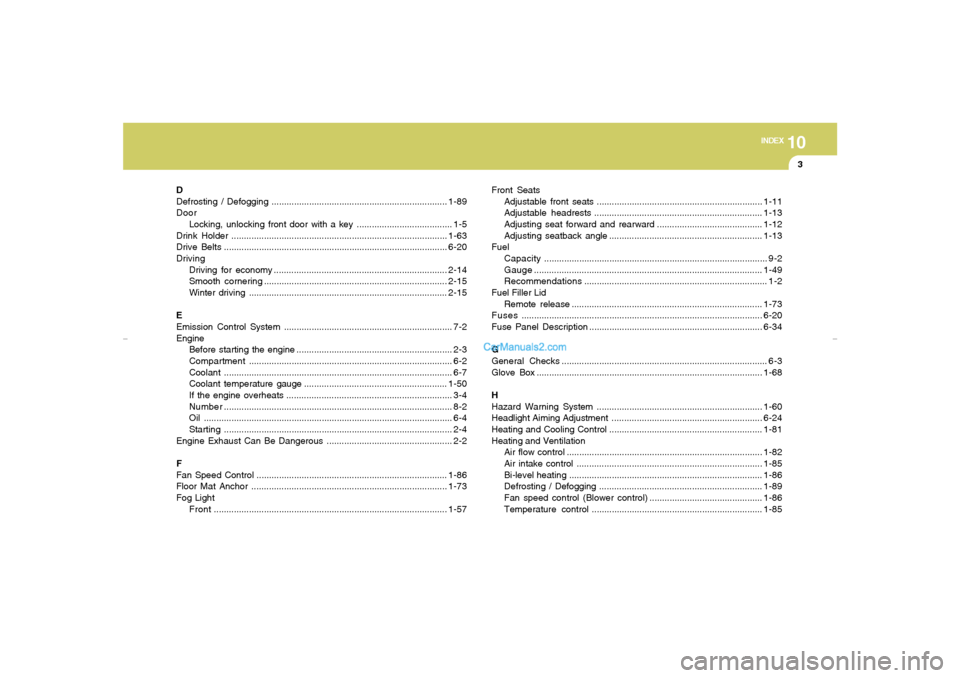coolant capacity Hyundai Elantra 2005 Owner's Manual
[x] Cancel search | Manufacturer: HYUNDAI, Model Year: 2005, Model line: Elantra, Model: Hyundai Elantra 2005Pages: 256, PDF Size: 10.4 MB
Page 201 of 256

6
DO-IT-YOURSELF MAINTENANCE8
G050D03A-AATTo Change the Engine CoolantThe engine coolant should be changed at those
intervals specified in the vehicle maintenance
schedule in Section 5.
CAUTION:
Engine coolant can damage the finish of
your car. If you spill engine coolant on the
car, wash it off thoroughly with clean water.
1. Park the car on level ground, set the park-
ing brake and remove the radiator cap when
cool.
2. Be sure your drain receptacle is in place.
Open the drain cock on the radiator. Allow all
the engine coolant to drain from the cooling
system, then securely close the drain cock.
3. Check Section 9 for the capacity of the
cooling system in your car. Then, following
the manufacturer's directions on the engine
coolant container, add the appropriate quan-
tity of coolant to the radiator.
!
4. Turn the radiator cap counterclockwise with-
out pressing down on it, until it stops. This
relieves any pressure remaining in the cool-
ing system. And remove the radiator cap by
pushing down and turning counterclock-
wise.
Now fill the radiator with clean demineralized
or distilled water. Continue to add clean
demineralized or distilled water in small quan-
tities until the fluid level stays up in the
radiator neck.
G050D03E
G050D01E G050C01A-AAT
To Check the Coolant LevelThe coolant level can be seen on the side of the
plastic coolant reservoir. The level of the cool-
ant should be between the "L" and "F" lines on
the reservoir when the engine is cold. If the level
is below the "L" mark, add engine coolant to
bring it up between "L" and "F". If the level is low,
inspect for coolant leaks and recheck the fluid
level frequently. If the level drops again, visit
your Hyundai dealer for an inspection and
diagnosis of the reason.
!
WARNING:
Remove the radiator cap when the radiator
is cool.
xdflhma-6.p652/5/2008, 2:13 PM 8
Page 205 of 256

6
DO-IT-YOURSELF MAINTENANCE
12
FILLING THE WASHER RESERVOIRG090A02A-AATThe washer fluid reservoir supplies fluid to the
windshield washer systems.
A good quality washer fluid should be used to fill
the washer reservoir. The fluid level should be
checked more frequently during inclement
weather or whenever the washer system is in
more frequent use.
The capacity of the washer reservoir is 3.2 U.S.
quarts (3.0 Liters).
G090A01E-A
CHECKING THE TRANSAXLE OIL
CAUTION:
o Radiator anti-freeze (engine coolant)
should not be used in the washer system
because it will damage the car's finish.
o The washer should not be operated if
the washer reservoir is empty. This can
damage the washer fluid pump.
!
G100A04A-AATMANUAL TRANSAXLETransaxle lubricant in the manual transaxle
should be checked at those intervals specified
in the vehicle maintenance schedule in Section
5.Recommended OilUse only HYUNDAI GENUINE PARTS MTF
75W/85 (API GL-4) or equivalent in the manual
transaxle.Manual Transaxle Oil CapacityThe oil capacity of the manual transaxle is 2.27
U.S. quarts (2.15 liters).
G100A01A
Drain plug Filler plug
!
WARNING:
o Windshield washer fluid agents contain
some amounts of alcohol and can be
flammable under certain circumstances.
Do not allow sparks or flame to contact
the washer fluid or the washer fluid
reservoir. Damage to the vehicle or its
occupants could occur.
o Windshield washer fluid is poisonous to
humans and animals. Do not drink wind-
shield washer fluid. Serious injury or
death could occur.
xdflhma-6.p652/5/2008, 2:13 PM 12
Page 252 of 256

10
INDEX
3
D
Defrosting / Defogging ......................................................................1-89
Door
Locking, unlocking front door with a key ...................................... 1-5
Drink Holder ......................................................................................1-63
Drive Belts.........................................................................................6-20
Driving
Driving for economy .....................................................................2-14
Smooth cornering.........................................................................2-15
Winter driving...............................................................................2-15
E
Emission Control System ................................................................... 7-2
Engine
Before starting the engine .............................................................. 2-3
Compartment................................................................................. 6-2
Coolant........................................................................................... 6-7
Coolant temperature gauge .........................................................1-50
If the engine overheats .................................................................. 3-4
Number........................................................................................... 8-2
Oil ................................................................................................... 6-4
Starting........................................................................................... 2-4
Engine Exhaust Can Be Dangerous .................................................. 2-2
F
Fan Speed Control............................................................................1-86
Floor Mat Anchor ..............................................................................1-73
Fog Light
Front.............................................................................................1-57Front Seats
Adjustable front seats ..................................................................1-11
Adjustable headrests...................................................................1-13
Adjusting seat forward and rearward ..........................................1-12
Adjusting seatback angle .............................................................1-13
Fuel
Capacity......................................................................................... 9-2
Gauge...........................................................................................1-49
Recommendations......................................................................... 1-2
Fuel Filler Lid
Remote release............................................................................1-73
Fuses ................................................................................................6-20
Fuse Panel Description.....................................................................6-34
G
General Checks.................................................................................. 6-3
Glove Box..........................................................................................1-68
H
Hazard Warning System ..................................................................1-60
Headlight Aiming Adjustment ............................................................
6-24
Heating and Cooling Control.............................................................1-81
Heating and Ventilation
Air flow control..............................................................................1-82
Air intake control ..........................................................................1-85
Bi-level heating.............................................................................1-86
Defrosting / Defogging .................................................................1-89
Fan speed control (Blower control).............................................1-86
Temperature control....................................................................1-85
xdflhma-10.p652/5/2008, 2:18 PM 3